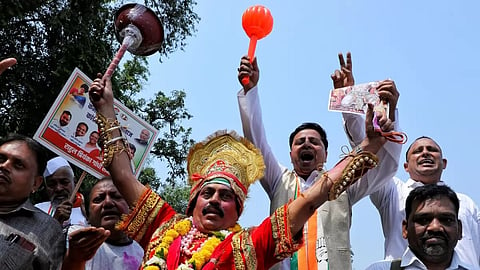After the iconic evocation of Lord Rama and Shiva for several years, it was the turn of a symbolic battle over Bajrang Bali in Karnataka Assembly elections. As the results provided Congress with the much-awaited victory, the party workers in the Delhi office were found decked up in the costumes of Lord Hanuman. Adorn with the maces (gada) and dresses of Hanuman, the air was covered by the slogans of ‘Bajrang Bali ki jai’.
The Karnataka assembly election campaign whereas brought in several policy issues – ranging from corruption to the rights of women and transgender community – in its last leg, lord Hanuman became a matter of contention. It started with the release of Congress manifesto where the party promised to ban Bajrang Dal for spewing hatred and provoking communalism in the society. The grand old party also compared the right-wing organisation with Popular Front of India (PFI) that the Central government banned a few months back citing its alleged involvement in terrorist activities.
No sooner than the manifesto was released, Bajrang Bali became a political rhetoric. While BJP attacked Congress for being anti-Hindu, Prime Minister Narendra Modi himself threw his hat in the turf and during his campaign in Uttara Kannada said that earlier the party tried to lock up the devotees of Ram and now they are trying to do the same with the devotees of Lord Hanuman. He started his speech with the slogans of ‘Bajrang Bali ki jai’ and asked the voters to not forget chanting it while casting their franchise.
Hanuman Is Angry; But At Whom?
The Karnataka assembly election campaign whereas brought in several policy issues- ranging from corruption to the rights of women and transgender community- in its last leg, lord Hanuman became a matter of contention
Opposing the efforts of PM Modi to connect Bajrang Dal and Bajrang Bali, Congress president Mallikarjun Kharge in an interview with a TV channel said, “Jai Bajrang Bali, Tod de Bhrashtachar ki nali.” Flexing his alignment to Lord Hanuman, he pointed out that he has made more than 80 Hanuman temples in his constituency. Congress also filed a complaint to the Election Commission (EC) against Modi for evoking the name of the Hindu god.
In this backdrop, the drubbing of BJP in the Karnataka elections, scholars think, is a response to the religious rhetoric that couldn’t stand a chance in front of developmental planks. However, this is not the first time in recent years that the major political parties have evoked Lord Hanuman in their political campaigns.
In April, PM Modi while addressing the party members on 44th foundation day of BJP invoked the reference of Bajrang Bali and said that the party has taken up a ‘can do attitude’ like lord Hanuman to eradicate corruptions. Earlier, in 2020, the battle of Delhi Assembly elections almost turned out to be a fight between evocation of Jai Shree Ram and Hanuman Chalisa. To establish his Hindu credentials, Delhi CM Arvind Kejriwal recited Hanuman Chalisa in public. While he fought the elections on developmental plank in an effort to change the narrative of the electoral fight, he couldn’t avoid the essentiality of identity politics. Yesterday, as the results of Karnataka assembly elections were coming out, media spotted Priyanka Gandhi in a Hanuman temple at Shimla.
BJP’s relation with Lord Hanuman, nonetheless, has not been that well for years. In 2018, during campaigns for Rajasthan Assembly Elections, UP CM Yogi Adityanath allegedly said that Hanuman was the representative of the deprived and marginalised caste. Another BJP leader and UP MLC Bukkal Nawab called Hanuman a ‘Muslim’. The statement of state minister Raaghuraj Singh also followed where he called him a ‘Thakur’.

Such caste-induced identity formation of Hanuman was strongly opposed by different right-wing organisations. Akhil Bharat Hindu Mahasabha (ABHM), expressing their discontent, wrote to Union Minister Amit Shah, “We will not tolerate such bizarre statements against our deities at any cost. They should be punished for the same and if no action is taken against them, we will start working to oust you (BJP) from power. Non-action against these leaders will prove that the BJP leadership has given them a free hand to say whatever they want against our gods.”
However, in the recent times, the party has been found evoking Lord Hanuman frequently. But the connection made by Bajrang Dal and Bajrang Bali is a fresh addition in the current context.
Bajrang Dal, the youth wing of Vishwa Hindu Parishad came into shape in 1984 to protect a Ram-Janaki Nath Yatra of a few saints from Ayodhya. The website of the organisation clearly says the context of their formation and refers to their objective to gather youths in favour of Ram Janmabhoomi movement.
The youth wing since its day of inception, nevertheless, has been known for all wrong reasons – from attacking couples on Valentine’s Day to participating in the alleged cow slaughters. While they were banned for only one year after the demolition of Babri Masjid in 1992, several political parties frequently called for its ban. In 2008, Lok Janashakti Party leader (LJP) Ram Bilas Paswan called for its banning. It was echoed by Bahujan Samajwadi Party (BSP) leader Mayawati in 2013. In 2002, a few media even reported that the then BJP Prime Minister Atal Bihari Vajpayee asked the organisation to tone down.
So, the Congress’s call for Bajrang Dal’s ban was not unprecedented. However, it was never considered as a humiliation to Bajrang Bali. Perhaps, this is the reason why Congress supporters have come up in Bajrang Bali attire to show – in words of Shiv Sena UBT leader Priyanka Chaturvedi – “even Bajrang Bali has given a thumbs down to Modi ji’s campaign in Karnataka”.
As several youths across India now put the stickers of Angry Hanuman, an iconic design made by Kerala’s Karan Acharya, in their cars – the question remains – Hanuman is Angry, but at whom?
Tags